maintenance Hyundai Equus 2016 Owner's Manual
[x] Cancel search | Manufacturer: HYUNDAI, Model Year: 2016, Model line: Equus, Model: Hyundai Equus 2016Pages: 477, PDF Size: 16.25 MB
Page 4 of 477
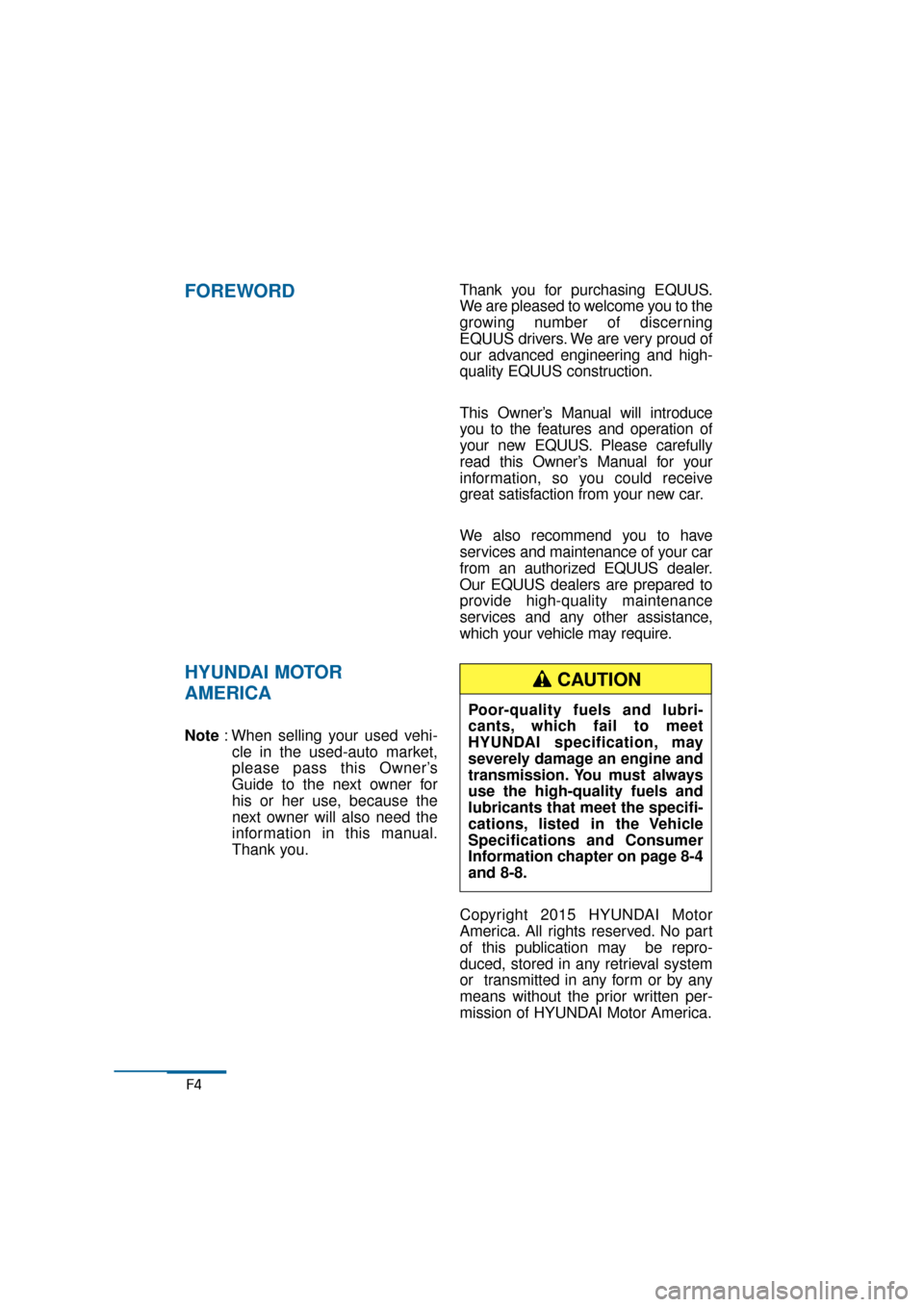
F4
FOREWORD
HYUNDAI MOTOR
AMERICA
Note: When selling your used vehi-
cle in the used-auto market,
please pass this Owner’s
Guide to the next owner for
his or her use, because the
next owner will also need the
information in this manual.
Thank you. Thank you for purchasing EQUUS.
We are pleased to welcome you to the
growing number of discerning
EQUUS drivers. We are very proud of
our advanced engineering and high-
quality EQUUS construction.
This Owner’s Manual will introduce
you to the features and operation of
your new EQUUS. Please carefully
read this Owner’s Manual for your
information, so you could receive
great satisfaction from your new car.
We also recommend you to have
services and maintenance of your car
from an authorized EQUUS dealer.
Our EQUUS dealers are prepared to
provide high-quality maintenance
services and any other assistance,
which your vehicle may require.
Copyright 2015 HYUNDAI Motor
America. All rights reserved. No part
of this publication may be repro-
duced, stored in any retrieval system
or transmitted in any form or by any
means without the prior written per-
mission of HYUNDAI Motor America.
Poor-quality fuels and lubri-
cants, which fail to meet
HYUNDAI specification, may
severely damage an engine and
transmission. You must always
use the high-quality fuels and
lubricants that meet the specifi-
cations, listed in the Vehicle
Specifications and Consumer
Information chapter on page 8-4
and 8-8.
CAUTION
Page 13 of 477
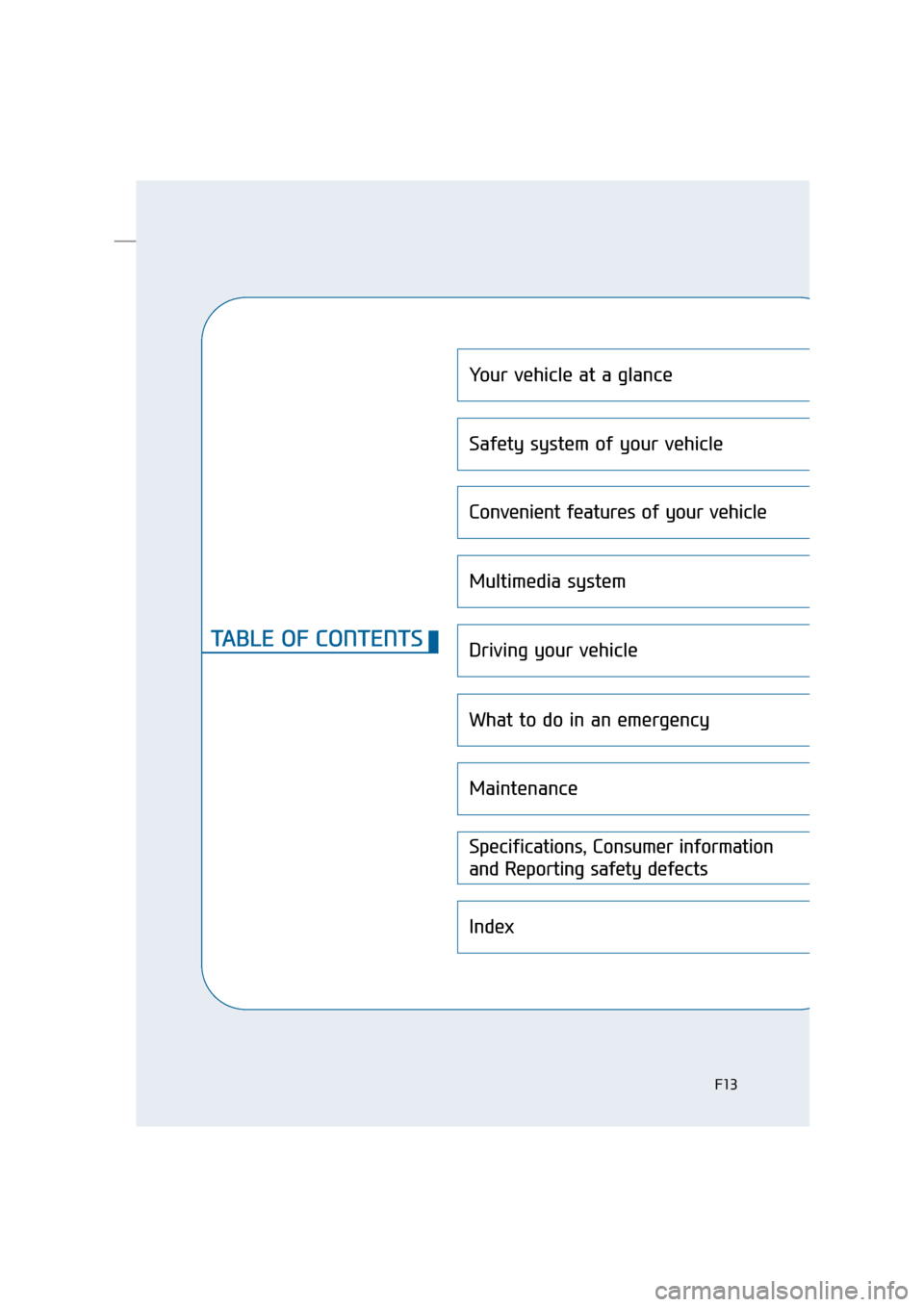
Your vehicle at a glance
Safety system of your vehicle
Convenient features of your vehicle
Multimedia system
Driving your vehicle
What to do in an emergency
Maintenance
Specifications, Consumer information
and Reporting safety defects
Index
TABLE OF CONTENTS
F13
Page 19 of 477
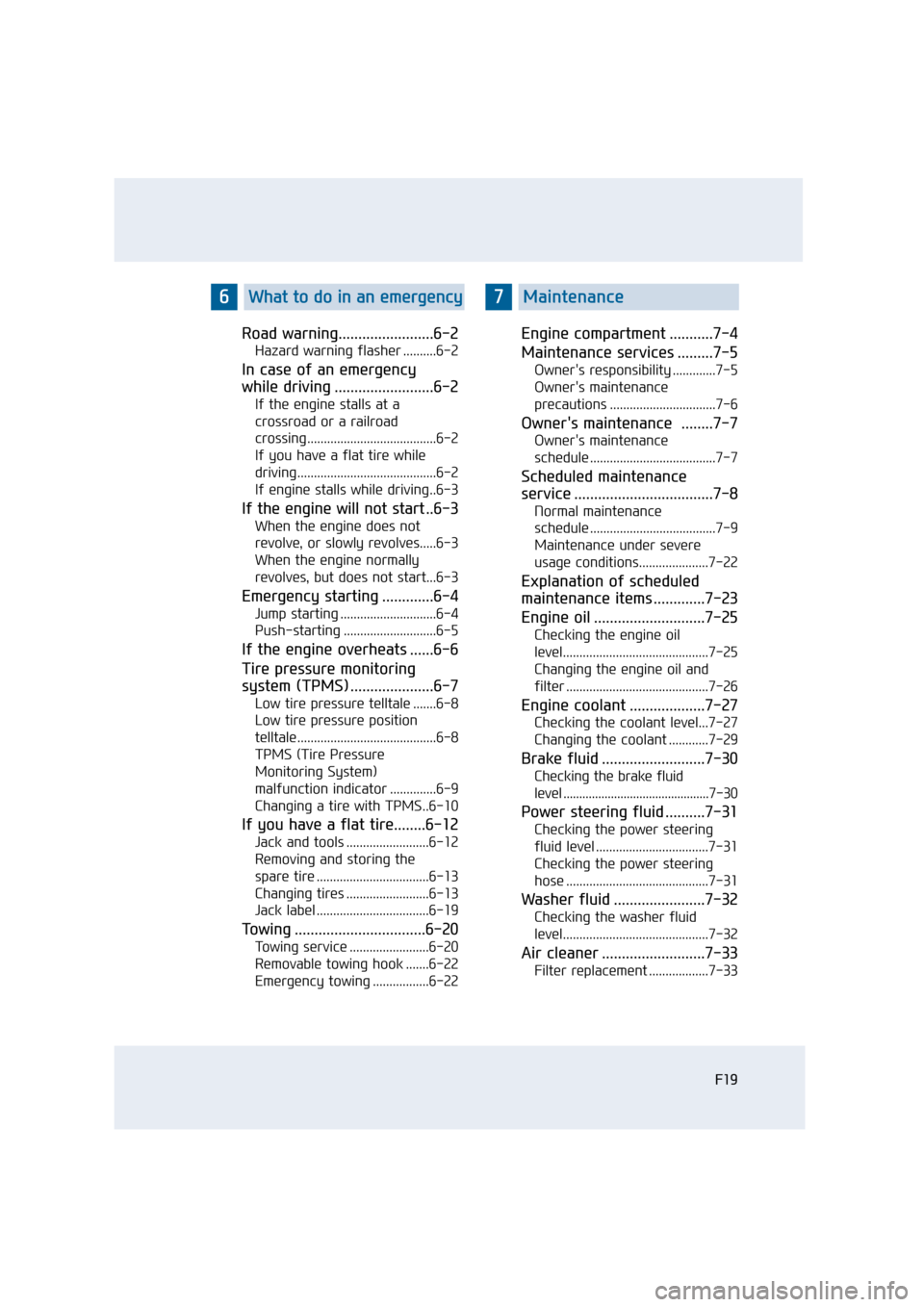
Road warning........................6-2
Hazard warning flasher ..........6-2
In case of an emergency
while driving .........................6-2
If the engine stalls at a
crossroad or a railroad
crossing.......................................6-2
If you have a flat tire while
driving..........................................6-2
If engine stalls while driving..6-3
If the engine will not start ..6-3
When the engine does not
revolve, or slowly revolves.....6-3
When the engine normally
revolves, but does not start...6-3
Emergency starting .............6-4
Jump starting .............................6-4
Push-starting ............................6-5
If the engine overheats ......6-6
Tire pressure monitoring
system (TPMS) .....................6-7
Low tire pressure telltale .......6-8
Low tire pressure position
telltale..........................................6-8
TPMS (Tire Pressure
Monitoring System)
malfunction indicator ..............6-9
Changing a tire with TPMS..6-10
If you have a flat tire........6-12
Jack and tools .........................6-12
Removing and storing the
spare tire ..................................6-13
Changing tires .........................6-13
Jack label ..................................6-19
Towing .................................6-20
Towing service ........................6-20
Removable towing hook .......6-22
Emergency towing .................6-22
Engine compartment ...........7-4
Maintenance services .........7-5
Owner's responsibility .............7-5
Owner's maintenance
precautions ................................7-6
Owner's maintenance ........7-7
Owner's maintenance
schedule ......................................7-7
Scheduled maintenance
service ...................................7-8
Normal maintenance
schedule ......................................7-9
Maintenance under severe
usage conditions.....................7-22
Explanation of scheduled
maintenance items .............7-23
Engine oil ............................7-25
Checking the engine oil
level............................................7-25
Changing the engine oil and
filter ...........................................7-26
Engine coolant ...................7-27
Checking the coolant level...7-27
Changing the coolant ............7-29
Brake fluid ..........................7-30
Checking the brake fluid
level ..............................................7-30
Power steering fluid ..........7-31
Checking the power steering
fluid level ..................................7-31
Checking the power steering
hose ...........................................7-31
Washer fluid .......................7-32
Checking the washer fluid
level............................................7-32
Air cleaner ..........................7-33
Filter replacement ..................7-33
F19
6What to do in an emergency7Maintenance
Page 20 of 477
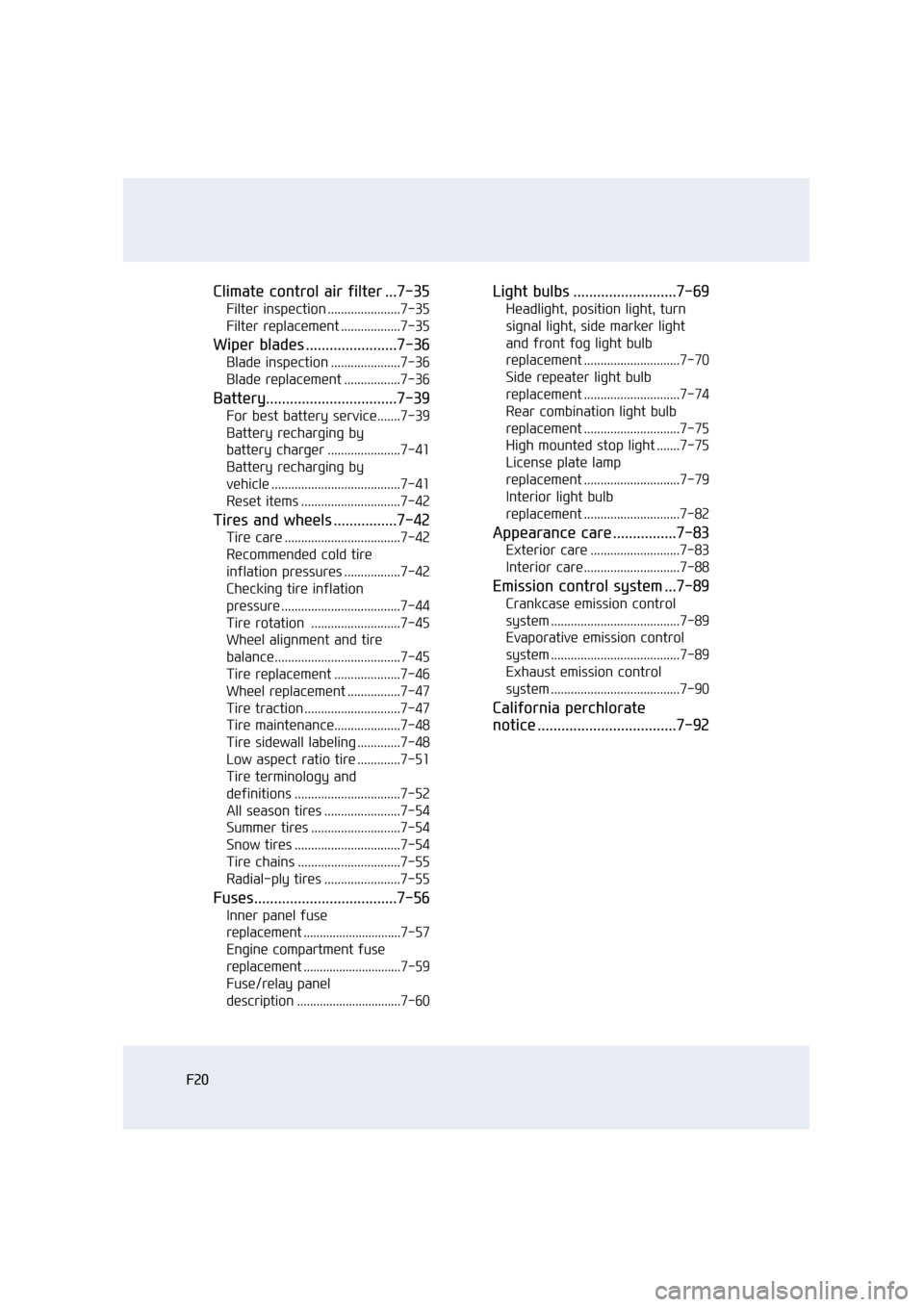
F20
Climate control air filter ...7-35
Filter inspection ......................7-35
Filter replacement ..................7-35
Wiper blades .......................7-36
Blade inspection .....................7-36
Blade replacement .................7-36
Battery.................................7-39
For best battery service.......7-39
Battery recharging by
battery charger ......................7-41
Battery recharging by
vehicle .......................................7-41
Reset items ..............................7-42
Tires and wheels ................7-42
Tire care ...................................7-42
Recommended cold tire
inflation pressures .................7-42
Checking tire inflation
pressure ....................................7-44
Tire rotation ...........................7-45
Wheel alignment and tire
balance......................................7-45
Tire replacement ....................7-46
Wheel replacement ................7-47
Tire traction .............................7-47
Tire maintenance....................7-48
Tire sidewall labeling .............7-48
Low aspect ratio tire .............7-51
Tire terminology and
definitions ................................7-52
All season tires .......................7-54
Summer tires ...........................7-54
Snow tires ................................7-54
Tire chains ...............................7-55
Radial-ply tires .......................7-55
Fuses....................................7-56
Inner panel fuse
replacement ..............................7-57
Engine compartment fuse
replacement ..............................7-59
Fuse/relay panel
description ................................7-60
Light bulbs ..........................7-69
Headlight, position light, turn
signal light, side marker light
and front fog light bulb
replacement .............................7-70
Side repeater light bulb
replacement .............................7-74
Rear combination light bulb
replacement .............................7-75
High mounted stop light .......7-75
License plate lamp
replacement .............................7-79
Interior light bulb
replacement .............................7-82
Appearance care ................7-83
Exterior care ...........................7-83
Interior care.............................7-88
Emission control system ...7-89
Crankcase emission control
system .......................................7-89
Evaporative emission control
system .......................................7-89
Exhaust emission control
system .......................................7-90
California perchlorate
notice ...................................7-92
Page 92 of 477
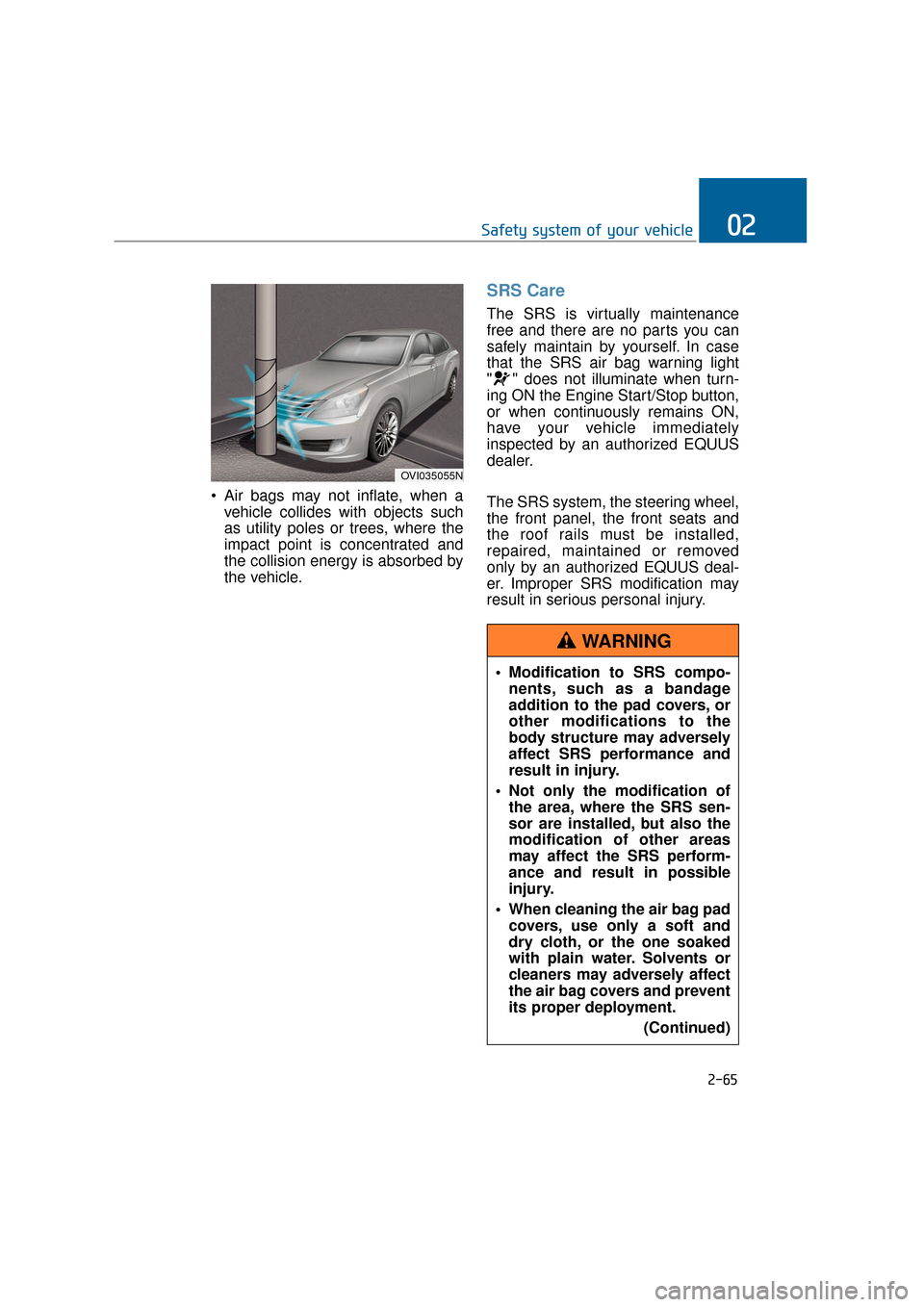
Air bags may not inflate, when avehicle collides with objects such
as utility poles or trees, where the
impact point is concentrated and
the collision energy is absorbed by
the vehicle.
SRS Care
The SRS is virtually maintenance
free and there are no parts you can
safely maintain by yourself. In case
that the SRS air bag warning light
" " does not illuminate when turn-
ing ON the Engine Start/Stop button,
or when continuously remains ON,
have your vehicle immediately
inspected by an authorized EQUUS
dealer.
The SRS system, the steering wheel,
the front panel, the front seats and
the roof rails must be installed,
repaired, maintained or removed
only by an authorized EQUUS deal-
er. Improper SRS modification may
result in serious personal injury.
2-65
Safety system of your vehicle02
OVI035055N
Modification to SRS compo-nents, such as a bandage
addition to the pad covers, or
other modifications to the
body structure may adversely
affect SRS performance and
result in injury.
Not only the modification of the area, where the SRS sen-
sor are installed, but also the
modification of other areas
may affect the SRS perform-
ance and result in possible
injury.
When cleaning the air bag pad covers, use only a soft and
dry cloth, or the one soaked
with plain water. Solvents or
cleaners may adversely affect
the air bag covers and prevent
its proper deployment.
(Continued)
WARNING
Page 163 of 477
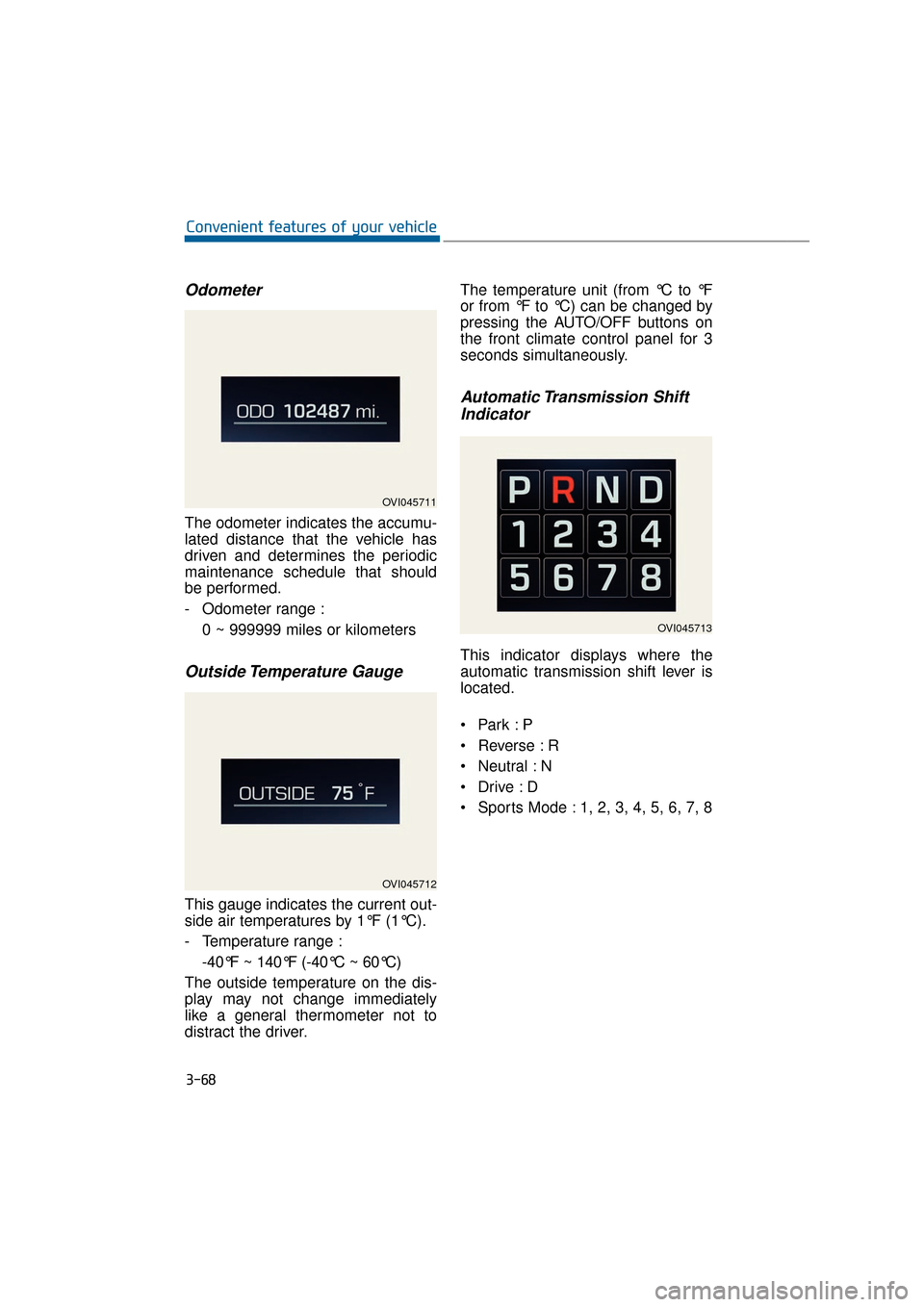
Odometer
The odometer indicates the accumu-
lated distance that the vehicle has
driven and determines the periodic
maintenance schedule that should
be performed.
- Odometer range :0 ~ 999999 miles or kilometers
Outside Temperature Gauge
This gauge indicates the current out-
side air temperatures by 1°F (1°C).
- Temperature range :-40°F ~ 140°F (-40°C ~ 60°C)
The outside temperature on the dis-
play may not change immediately
like a general thermometer not to
distract the driver. The temperature unit (from °C to °F
or from °F to °C) can be changed by
pressing the AUTO/OFF buttons on
the front climate control panel for 3
seconds simultaneously.
Automatic Transmission Shift
Indicator
This indicator displays where the
automatic transmission shift lever is
located.
Reverse : R
Neutral : N
Sports Mode : 1, 2, 3, 4, 5, 6, 7, 8
3-68
Convenient features of your vehicle
OVI045711
OVI045712
OVI045713
Page 166 of 477
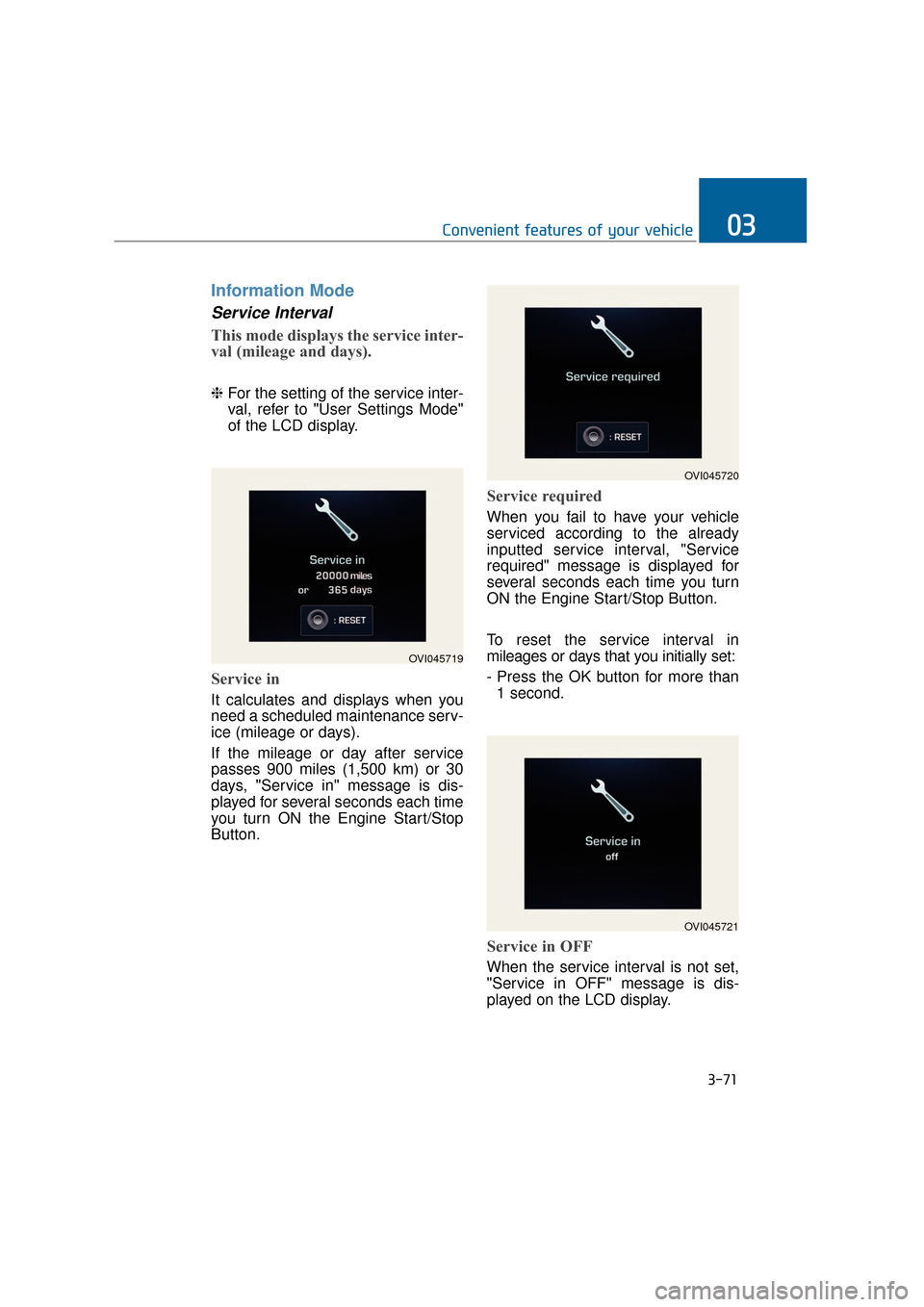
Information Mode
Service Interval
This mode displays the service inter-
val (mileage and days).
❈For the setting of the service inter-
val, refer to "User Settings Mode"
of the LCD display.
Service in
It calculates and displays when you
need a scheduled maintenance serv-
ice (mileage or days).
If the mileage or day after service
passes 900 miles (1,500 km) or 30
days, "Service in" message is dis-
played for several seconds each time
you turn ON the Engine Start/Stop
Button.
Service required
When you fail to have your vehicle
serviced according to the already
inputted service interval, "Service
required" message is displayed for
several seconds each time you turn
ON the Engine Start/Stop Button.
To reset the service interval in
mileages or days that you initially set:
- Press the OK button for more than
1 second.
Service in OFF
When the service interval is not set,
"Service in OFF" message is dis-
played on the LCD display.
3-71
Convenient features of your vehicle03
OVI045719
OVI045720
OVI045721
Page 232 of 477
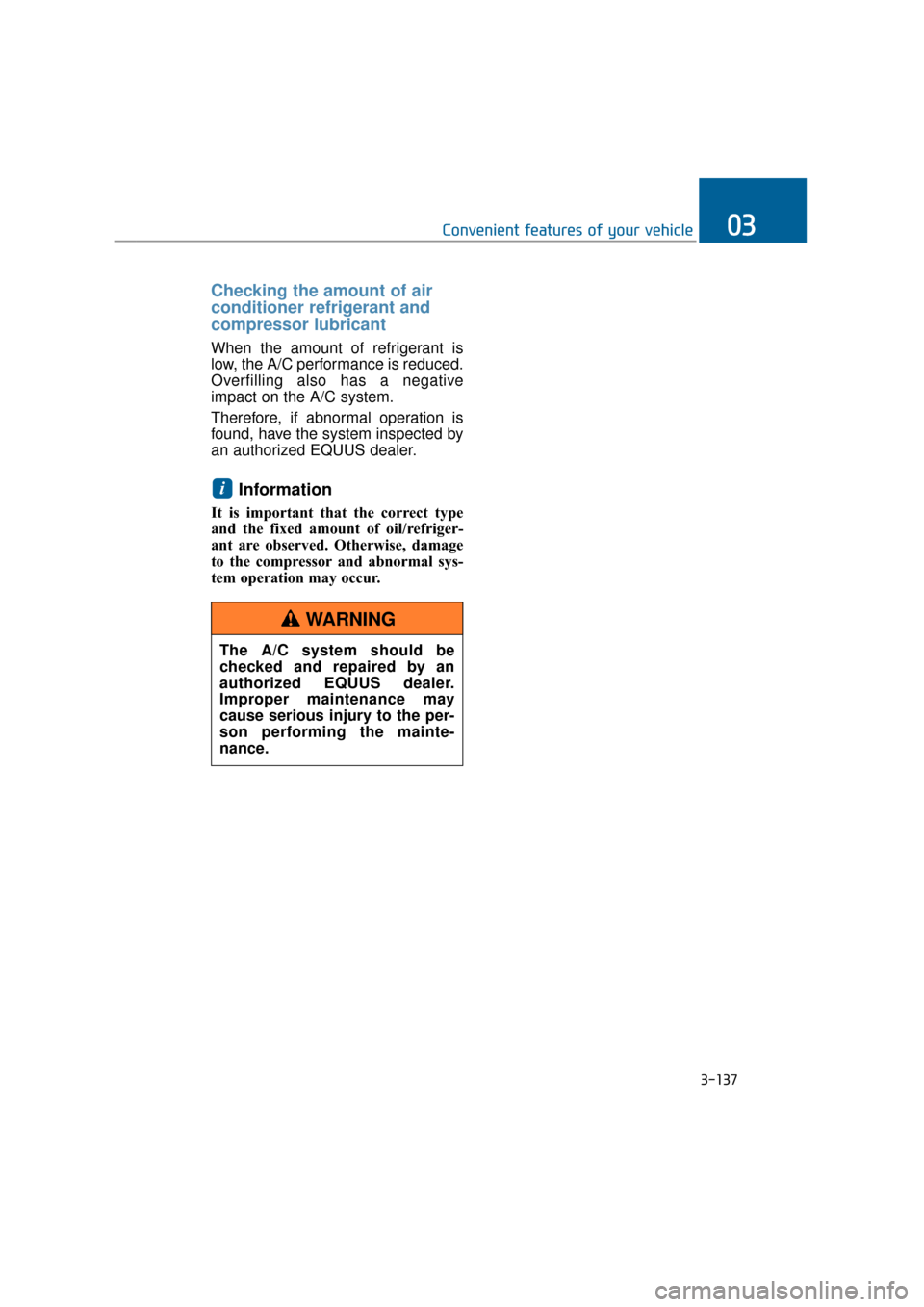
3-137
Convenient features of your vehicle03
Checking the amount of air
conditioner refrigerant and
compressor lubricant
When the amount of refrigerant is
low, the A/C performance is reduced.
Overfilling also has a negative
impact on the A/C system.
Therefore, if abnormal operation is
found, have the system inspected by
an authorized EQUUS dealer.
Information
It is important that the correct type
and the fixed amount of oil/refriger-
ant are observed. Otherwise, damage
to the compressor and abnormal sys-
tem operation may occur.
i
The A/C system should be
checked and repaired by an
authorized EQUUS dealer.
Improper maintenance may
cause serious injury to the per-
son performing the mainte-
nance.
WARNING
Page 256 of 477
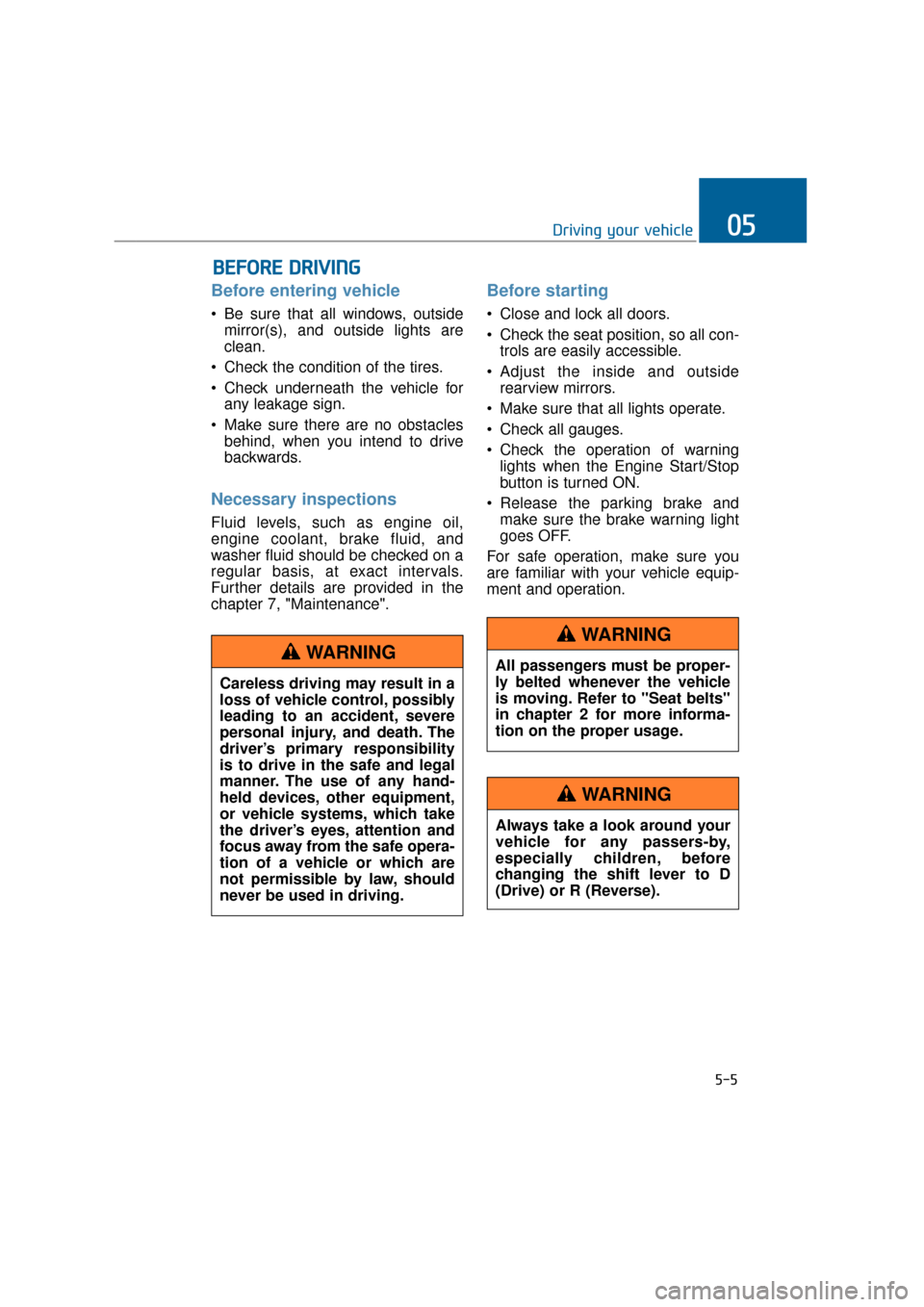
Before entering vehicle
• Be sure that all windows, outsidemirror(s), and outside lights are
clean.
Check the condition of the tires.
Check underneath the vehicle for any leakage sign.
Make sure there are no obstacles behind, when you intend to drive
backwards.
Necessary inspections
Fluid levels, such as engine oil,
engine coolant, brake fluid, and
washer fluid should be checked on a
regular basis, at exact intervals.
Further details are provided in the
chapter 7, "Maintenance".
Before starting
Close and lock all doors.
Check the seat position, so all con-trols are easily accessible.
Adjust the inside and outside rearview mirrors.
Make sure that all lights operate.
Check all gauges.
Check the operation of warning lights when the Engine Start/Stop
button is turned ON.
Release the parking brake and make sure the brake warning light
goes OFF.
For safe operation, make sure you
are familiar with your vehicle equip-
ment and operation.
B B E
EF
FO
O R
RE
E
D
D R
RI
IV
V I
IN
N G
G
5-5
Driving your vehicle05
Careless driving may result in a
loss of vehicle control, possibly
leading to an accident, severe
personal injury, and death. The
driver’s primary responsibility
is to drive in the safe and legal
manner. The use of any hand-
held devices, other equipment,
or vehicle systems, which take
the driver’s eyes, attention and
focus away from the safe opera-
tion of a vehicle or which are
not permissible by law, should
never be used in driving.
WARNINGAll passengers must be proper-
ly belted whenever the vehicle
is moving. Refer to "Seat belts"
in chapter 2 for more informa-
tion on the proper usage.
WARNING
Always take a look around your
vehicle for any passers-by,
especially children, before
changing the shift lever to D
(Drive) or R (Reverse).
WARNING
Page 316 of 477
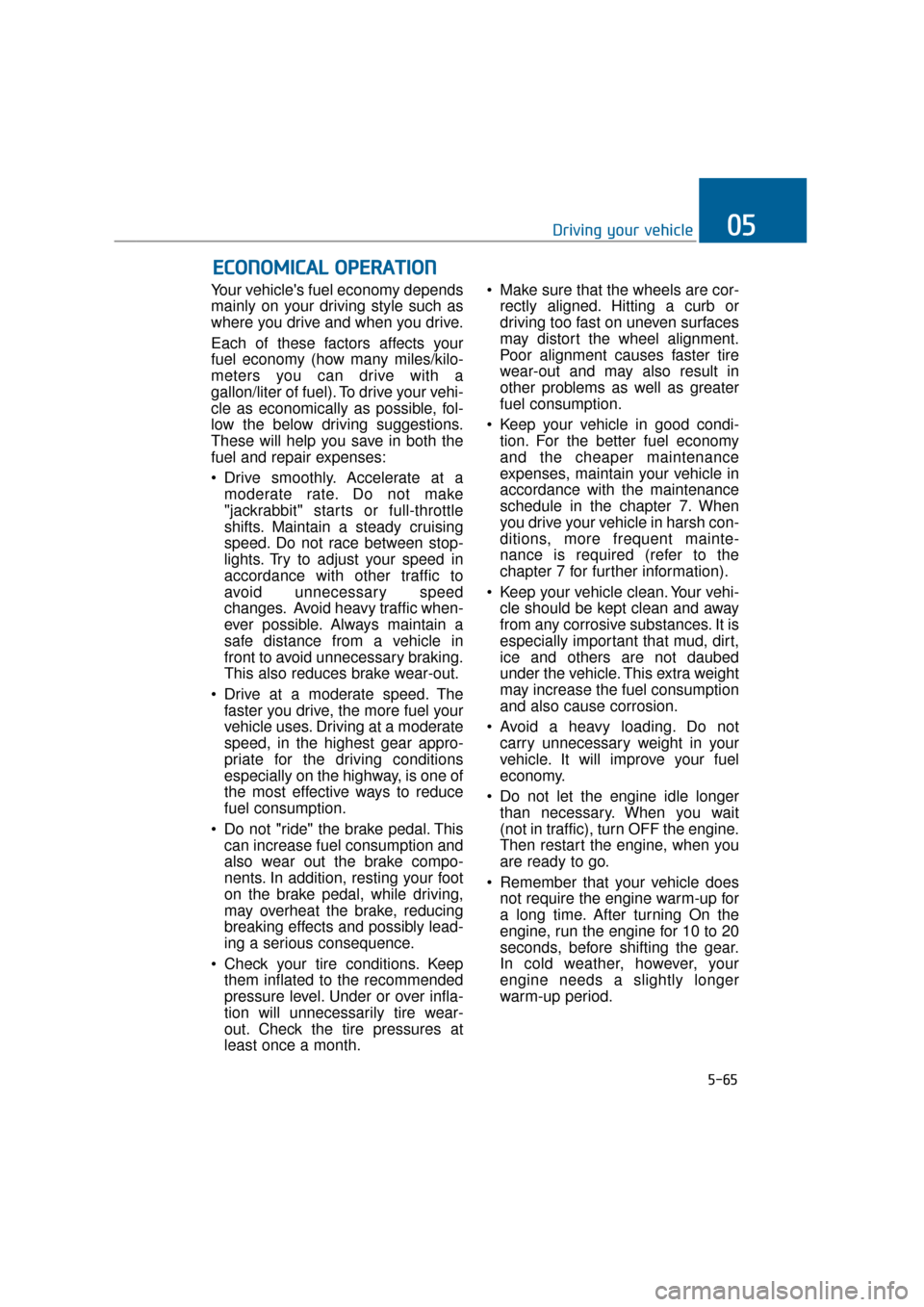
5-65
Driving your vehicle05
Your vehicle's fuel economy depends
mainly on your driving style such as
where you drive and when you drive.
Each of these factors affects your
fuel economy (how many miles/kilo-
meters you can drive with a
gallon/liter of fuel). To drive your vehi-
cle as economically as possible, fol-
low the below driving suggestions.
These will help you save in both the
fuel and repair expenses:
Drive smoothly. Accelerate at amoderate rate. Do not make
"jackrabbit" starts or full-throttle
shifts. Maintain a steady cruising
speed. Do not race between stop-
lights. Try to adjust your speed in
accordance with other traffic to
avoid unnecessary speed
changes. Avoid heavy traffic when-
ever possible. Always maintain a
safe distance from a vehicle in
front to avoid unnecessary braking.
This also reduces brake wear-out.
Drive at a moderate speed. The faster you drive, the more fuel your
vehicle uses. Driving at a moderate
speed, in the highest gear appro-
priate for the driving conditions
especially on the highway, is one of
the most effective ways to reduce
fuel consumption.
Do not "ride" the brake pedal. This can increase fuel consumption and
also wear out the brake compo-
nents. In addition, resting your foot
on the brake pedal, while driving,
may overheat the brake, reducing
breaking effects and possibly lead-
ing a serious consequence.
Check your tire conditions. Keep them inflated to the recommended
pressure level. Under or over infla-
tion will unnecessarily tire wear-
out. Check the tire pressures at
least once a month. Make sure that the wheels are cor-
rectly aligned. Hitting a curb or
driving too fast on uneven surfaces
may distort the wheel alignment.
Poor alignment causes faster tire
wear-out and may also result in
other problems as well as greater
fuel consumption.
Keep your vehicle in good condi- tion. For the better fuel economy
and the cheaper maintenance
expenses, maintain your vehicle in
accordance with the maintenance
schedule in the chapter 7. When
you drive your vehicle in harsh con-
ditions, more frequent mainte-
nance is required (refer to the
chapter 7 for further information).
Keep your vehicle clean. Your vehi- cle should be kept clean and away
from any corrosive substances. It is
especially important that mud, dirt,
ice and others are not daubed
under the vehicle. This extra weight
may increase the fuel consumption
and also cause corrosion.
Avoid a heavy loading. Do not carry unnecessary weight in your
vehicle. It will improve your fuel
economy.
Do not let the engine idle longer than necessary. When you wait
(not in traffic), turn OFF the engine.
Then restart the engine, when you
are ready to go.
Remember that your vehicle does not require the engine warm-up for
a long time. After turning On the
engine, run the engine for 10 to 20
seconds, before shifting the gear.
In cold weather, however, your
engine needs a slightly longer
warm-up period.
E EC
CO
O N
NO
O M
M I
IC
C A
A L
L
O
O P
PE
ER
R A
A T
TI
IO
O N
N